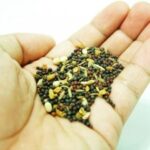From the Stone Age to the Middle Ages and to your hot dog today, the mustard plant has been around since time began. According to The Nibble (www.thenibble.com), fossils of the mustard seed as well as the plant itself have been found in Stone Age and Middle Age settlement ruins. Mustard was an important and chief spice before the Asian Spice Trade made its way to European countries. Even King Tut himself was buried with a large supply of mustard seeds to enjoy in the afterlife.
Originally, the mustard seed was used in medicine as a cure for scorpion stings as well as a variety of medicines and plasters. Even the Christian faith revered the mustard seed (and still do) in that something so small and insignificant can grow to such strength and power. Even Pope John XXII so loved his mustard that he created the office of Grand Moutardier du Pape, which is the Mustard Maker to the Pope. In 1866, Jeremiah Coleman perfected the technique of grinding the seeds into a fine powder without creating the heat which is brought about by the oils in the seeds. A process that is still used today (Coleman Mustard of England).
The folks at the Food Network state that the mustard plant is one of the few plants that is almost entirely edible in that (1) the seeds can be used for mustards or oils; (2) the leaves, if young, can be used in salads while the older larger leaves can be chopped and cooked with a ham bone or blanched and sautéed with a bit of olive oil and red pepper flakes; and (3) even the flowers make for an edible decoration. Each part holding a peppery tasted to them. Further, the mustard plant shares the same family as broccoli, brussel sprouts, collard, kale and even kohlrabi.
From all the mustard plants in the world, there are only three seed variations that are used. White seeds hail from the Mediterranean region and they are the most common. These seeds become the yellow mustard on our hot dogs. Brown seeds come from the Himalayas and in turn end up as the spicy mustard that is found in American Chinese restaurants. Finally, the Black seeds are exclusively found in the Middle East and Asia Minor. These seeds are hand picked and can be found only within the region, although specialty food shops and online markets might have them.
Mustard is even good for one’s health. According to WebMD, the seeds of the mustard plant contain such properties as Isothiocyanates which help prevent the growth of some cancers while Selenium helps and the severity of asthma and rheumatoral arthritis and finally there is Magnesium which helps reduce high blood pressure and the pain of migraine headaches. But like all things, one should take in moderation and check with their physician.
Of all three seeds there are nine well known variations of the little seed that create mustards from around the world. The people of Food Network claim that the following nine are:
1. Dijon: Comes from France and has been made since 1856. The seeds are ground and mixed with either white or burgundy wines to produce there distinctive mild taste.
2. Yellow: Invented in 1904 and since then has been the standard mustard that is used in American from everything from hot dogs to potato salad and dressings.
3. Wholegrain: The seeds are not ground into a fine powder, only cracked so that the whole seed remains intact. It is mixed with other ingredients to give it its texture.
4. Honey: Just as the name states. The mustard powder is mixed with honey in equal parts to give it body. Sometimes peppers and other spices are used to give the mustard a stronger kick.
5. English: Bright yellow, much like classic American Yellow mustard, but much hotter. It is often called “English Wasabi” and like Wasabi is used sparingly.
6. French: is a dark yellow than most mustards as there is more vinegar used, thus giving it a milder flavor.
7. Irish: This wholegrain mustard is mixed with honey and/or Irish whiskey to give it its kick and flavor.
8. Chinese: Is nothing more than mustard powder and water. The more it is mixed the fierier it becomes because there is more of the hot oil that is being released. Seen in American Chinese food markets and restaurants.
9. Horseradish: The addition of horseradish gives a slightly sourer flavor as well as adding its own heat to the mustard. This mustard can come mild or even hotter than English mustard.
No longer does a person have to stick with one mustard. Experiment, try new flavors and heat levels. You will never know the beauty of mustard until you try for yourself.






